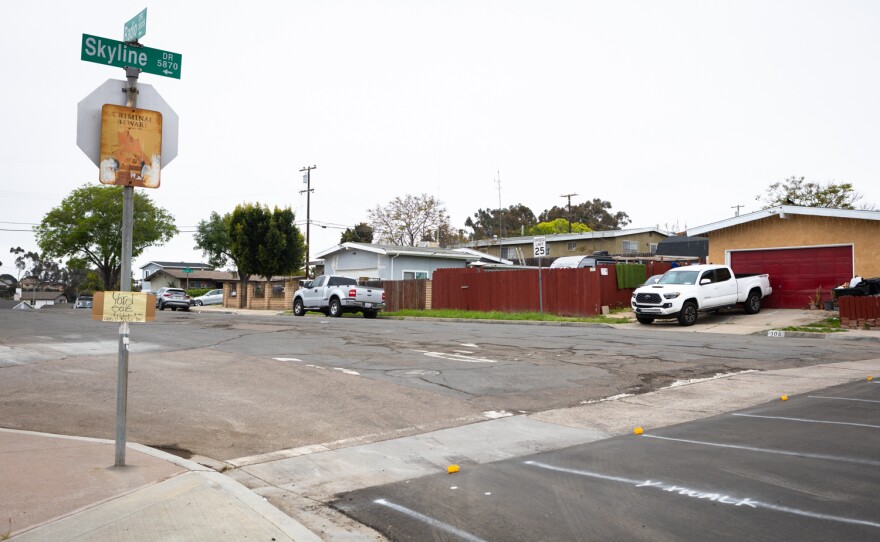San Diego city leaders don’t want to force themselves to dedicate money every year to fund crumbling roads, but they will look into hiring city workers instead of private contractors to catch up on the city’s road maintenance backlog.
Those decisions are part of the city’s response to the San Diego County Grand Jury, which investigates and evaluates local government operations. In June, the grand jury issued a detailed report about San Diego’s extensive street pavement challenges and made a total of seven recommendations to city officials.
A key recommendation was establishing a new law that would dedicate funding for roads from its annual budget, which some local officials say is necessary to ensure road maintenance and repairs are handled.
In a meeting of the City Council’s transportation and infrastructure committee last week, members unanimously voted to follow all the grand jury’s recommendations except one: creating the law to guarantee funding for road repairs.
The full City Council must approve the committee’s response to the grand jury by an extended deadline of Nov. 21 and implement most of the recommendations by June 2024.
The committee did express interest in studying the costs and benefits of bringing street repair and maintenance “in-house.” Similar business models already exist within the city for trash collection and stormwater pipe repairs, city staff said at the meeting.
Jordan More, a city budget analyst, said most cities don't usually employ in-house workers for street repair projects, because they don't have enough projects to work on. But San Diego might need to “start rethinking” that possibility, he said, especially given the city’s growing backlog.

In the city’s draft response to the grand jury, budget analysts said this approach “could allow for better labor cost control.”
“We have the ability to start small and to be able to bring that in-house and to start to change the marketplace as far as materials, resources and funding are concerned,” Bethany Bezak, the city’s director of transportation, told the committee last week.
Other grand jury recommendations the city plans to implement include improving usability of its street data webpage and developing a rolling five-year pavement plan to identify the streets the city intends to resurface.
San Diego Mayor Todd Gloria’s staff said during the meeting that he opposes creating a new funding stream for road repairs, because it would limit leaders' ability to use their discretion when budgeting for the city's many needs.
The committee and city staff ultimately agreed, concluding that the designated funding could prevent the city from spending money on more urgent projects.
“When it comes to tying funds to specific needs, especially through the future, our typical response is we feel that the best course of action is to maintain budget flexibility,” More, the city budget analyst, told the committee.
During the meeting, Council President Pro Tem Monica Montgomery Steppe echoed concerns from transportation staff who said they don’t see how the city can keep up with road repairs and maintenance without the designated funding.
“We are underwater here,” she said. “The plans are good and the assessments are good, but they are only as good as our commitment to the funding of them.”
Ultimately, Montgomery Steppe joined the rest of her committee members in voting against the new funding stream.
However, the committee voted that the city should explore mandating pavement condition assessments every four years starting in fiscal year 2027.

The grand jury has been flagging San Diego city roads for nearly two decades. It has cited a lack of funding for street repair and maintenance resulting in “a deplorable situation.”
The city grades street conditions on a 100-point scale and by classifying roads as good, fair or poor. The last time the city assessed street conditions was in 2015, and data from that year shows that city roads had an average score of 70, which barely made a “good” standing score.
San Diego is currently reevaluating its roads to get a more accurate picture of how street conditions have changed since the last assessment.
Bezak said early road assessment results show that the city’s overall condition index score has “gone down as expected,” which suggests San Diego roads would now be categorized as being in “poor” condition.
In the latest grand jury report released in June, the authors wrote that the city has been basing its annual street paving plans partially on an outdated road assessment, which underestimates the current and growing need for repairs. The cost to repair each mile of street is also increasing every year, and the budget hasn’t been keeping up, the grand jury wrote.
San Diego’s largest funding source for street paving is typically the state’s Road Repair and Accountability Act of 2017, which is primarily used to pay for slurry seal maintenance — a temporary way of paving a road by thickening it that also extends the life of the road. Since Fiscal Year 2020, San Diego has received $144 million from this bill.
Funds for asphalt overlay, which is a better long-term solution for paving the city’s busted roads, typically come from discretionary sources, such as bond debt, taxes, contractor fees and the general fund, which is the most flexible bucket of money within the city’s annual budget.
Montgomery Steppe said her district, which includes southeastern communities such as Encanto, Paradise Hills and Mountain View, has a lot of older streets with historically little slurry seal maintenance and even fewer overlays.
She said the city keeps relying on slurry seals because it’s cheaper, but doing so “widens a disparity gap” in communities that need bigger investments in their roads.
Bezak said that the final index score will become available in November.










